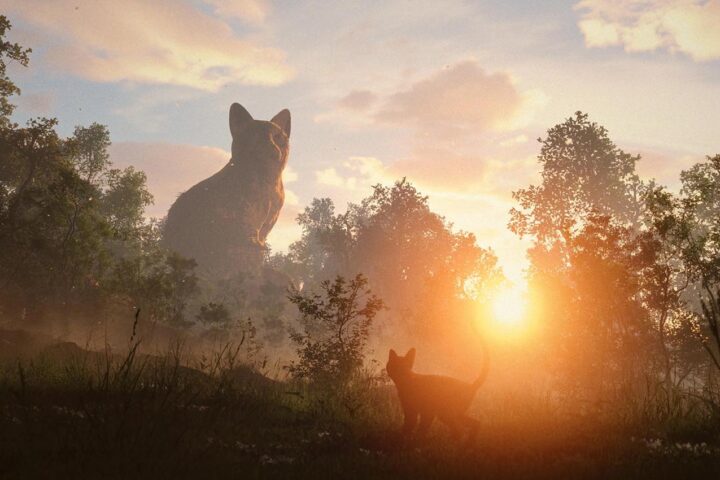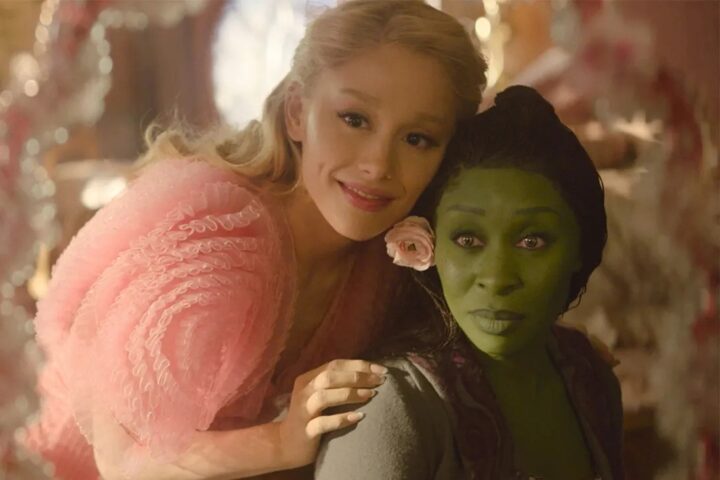Gints Zilbalodis’s Flow might be wordless, but that’s not for lack of its maker having things to say. In Zilbalodis’s sophomore feature, the Latvian animator expands from a one-man operation into overseeing a fleet of technicians to create a vast, imagined world. Within a landscape defined by the creeping presence of a great flood and a conspicuous lack of humans, an intrepid black cat must learn to cooperate with a wide array of creatures to survive. Even without language, it’s never in doubt what the animals perceive or feel at any given moment.
As the feline protagonist seeks higher ground from the rising tides, the story invites any number of allegorical readings, from a post-human retelling of the Noah’s Ark story or a warning about a climate change-ravaged Earth. Zilbalodis builds subtlety into each scene that can unlock layers of how the characters respond to the calamity surrounding them. But without being overly broad, Flow is big enough for people to project themselves into the film and see their own emotions and experiences reflected in the journey toward safety and solidarity.
I spoke with Zilbalodis during a stop in New York as he toured the world with Flow this fall. Our conversation covered how he leveled up to overseeing a full crew of animators, why he composed the score for the film as he wrote the screenplay, and what he hopes people will make of the film’s ambiguities given its pointed lack of exposition.
You made your previous animated feature, Away, by yourself. What were the benefits and challenges of bringing other people into your process?
It was a completely new experience for me, but it was always the plan to make that first feature myself and go through all these processes so that if I eventually had a chance to work in a team, I would understand everyone’s language and we could work more smoothly. It was basically my film school, making Away, and because of the success that it had at festivals, it allowed me to get the funding for Flow. But it was still a big challenge. I had to learn completely new skills because when I had an idea, I could just visualize it myself and make it. I didn’t have to explain it to anyone. Now, I had to articulate my thoughts and have a reason for everything.
It was also challenging for me to be responsible for all these people. I didn’t want to waste anyone’s time or budget. I’d never even worked in a studio, and now I had to be in charge of one! But the story of the film is about that. It’s about this cat who was used to being independent and self-sufficient, and then after the flood destroys the cat’s [home], it has to learn how to work with and trust others. It was really intentional doing that with Flow. When I wrote the script, I think I had imagined a lot of stuff going wrong, but the process of working with the team was much smoother. We were really supportive of each other, and I was quite lucky with that.
Did having to communicate some of the ideas in a way that other people could understand help clarify, or even change, anything in the script?
Unlike Away, in which I didn’t even have a finished script—I had an outline, and I would just improvise it visually—we needed the script for the funding. So I spent a long time alongside my producer and co-writer, Matiss Kaza, writing the script. But once it was finished, I started making animatics without even reading the script. I would just make it based on my memory of the writing. I also had music that I’d written at the same time as the script. I wasn’t using temp scores from other films, which helped me integrate the music a lot deeper. The music gave me ideas for the way that the story would go. And so, once I had the animatic finished, I would show that to the team. I didn’t show them the script. I think showing the visuals and the music told a lot more about my intentions, especially some of the scenes where the music is really in charge of everything and leading the story. It’s really hard to find words to explain these emotions, and it was much easier to show them the music. That really helped me in communicating everything.
How did you find the balance of letting the music be expressive but not telling the audience how they need to feel?
Exactly, it’s about finding that balance. Because the music is done early while the script isn’t completely finished, it’s really integrated. It’s not something added on top of the film. It’s not forced upon it; it’s gently guiding it. I also wanted to have enough time to develop these cues. Sometimes, a scene might develop this deeper emotion for four or five minutes, and the music is quite simple in terms of the notes. But it’s built upon layers upon layers of how the sounds are very subtly adjusted. Because it has enough time to develop, it feels at a comfortable pace. It’s not changing every 30 seconds into some different emotion. It’s more fluid and just giving you direction [in terms of where the story is going and how to feel] without being too specific about how you should feel about it. Also, there are long scenes with no music as well, where it’s just the sound. I think that helps us to feel more immersed in this world. Having these moments of quiet makes these louder moments feel even bigger because there’s that dynamic range.
They don’t speak, but there’s absolutely dialogue between the animals in the film. Were you scripting their conversations, even if just in your head?
I didn’t write specific words that they would say, but I would write “the cat is grumpy” or “the dog is annoying.” The script was quite direct, and a lot of the performances were built by our sound designer. Because we didn’t have voice actors, it was really the sound designer’s job to build all these voices. We used real animal voices. It’s not just the sound, but also the animation, that helped convey what they’re saying. It’s the way these characters are framed, how the light is falling on them, and how the editing helps us understand what they’re saying and feeling. You’re not supposed to think about it, but subconsciously, I think it affects how you perceive them.
Were you directly involved in the process of getting the animal voices?
I wasn’t really involved. My sound designer would record a lot of animals; he would record his cat as well. Most of the animals are the actual species. The only one that was more challenging for us was the capybara, which, in real life, almost doesn’t speak at all. They’re very silent. So Gurwal [Coïc-Gallas], our sound designer, would go to the zoo, and to get the capybara to say something, he would have to tickle it to make some noises. But the voice was so strange. It didn’t really fit this character because the capybara in our film is very chill, calm, and relaxed, and the voice of the real capybara was very high-pitched and anxious-sounding. We had to look for other animals, and eventually we settled on a baby camel. Sometimes if you show exactly real life, it becomes almost more unbelievable. You have to make some creative decisions to make it feel more real. But in terms of the performances, we had references for all the movements and wanted to keep things as grounded as possible. It’s all animated by hand; we didn’t record any motion capture. Because it’s so specific, we needed to build everything frame by frame.
Did you think of the animals in the film as anthropomorphized, or are you conceiving them with animal psychologies and just welcoming the audience to project human emotions onto them?
For the most part, we tried to keep them as believable as animals as possible. We studied real animals and while writing the script, we were making sure that they were behaving very instinctually. The motivations are very direct and clear. It’s very important that we understand all of them. Keeping things as simple as possible is the key to doing that.
But, still, it’s not a documentary. Sometimes, we needed to make sure that the animals have agency and are impacting the story. We did need to make them behave in less lifelike ways because if we didn’t do that, they would just be lost at sea with no story. Because we already didn’t have dialogue, we needed to use some of these other tools. But even for those moments, we would look for some real references to make sure that it was as grounded as possible.
I loved the recurring motif of the animals being drawn to their reflection. What do animals see in those moments? Do you think they possess the theory of mind?
One of the first things I thought [about] when writing the script was that the film would start with this cat looking at its reflection in the water. The water is very significant at that moment. It’s the cat literally reflecting upon itself, so it was a way for me to tie the film together [from] beginning to end, showing how the characters have changed. In the beginning, we see the water trembling. It’s disturbed as the cat’s anxiety grows, but in the end, it becomes more peaceful. That was also in the script. I think it’s a really simple but strong image.
For a long time, I couldn’t figure out how to bring it back to the same place. I realized that just having that similar image is enough. In terms of just staging all these scenes, because there are these long takes where the camera follows these characters, I tried to avoid cutting back and forth between shot-reverse shot reactions. Having these reflections often allowed me to have the action, but also we can see the reflection of the character within the same image. It makes it a lot more visually direct without any unnecessary movement. It’s a useful trick for blocking things.
On the note of the water, how much of its presence in the film is meant to be taken literally or metaphorically? I initially interpreted Flow as a fable about climate change, but you might have had other things on your mind.
It all starts with the characters for me. I knew that I wanted to tell a story about a cat that’s afraid of water, as most cats are, and I wanted to show how the cat learns how to overcome those fears. I wanted to show the biggest possible threat for this cat, so it was this big flood. I didn’t want any antagonist, so it’s really just the cat versus nature. All the animals are relatable in that sense. Nature itself is also not even an antagonist. We see these flooded cities, but it’s not post-apocalyptically bleak. It’s this quite beautiful way of seeing nature reclaiming these spaces.
These ideas of catastrophe grew naturally and organically. It wasn’t a deliberate starting point for me. If I was thinking in direct messages, I think the story could feel too forced. I think about the characters, and then these ideas emerge naturally. We don’t see the humans in the story, and we’re left wondering what happened to them. It’s left for the audience to think about that, but my own personal interpretation of that [is that] I think the humans were aware of this flood and left. The animals are left to fend for themselves, and I think it becomes a lot more emotional seeing the animals go through all this than seeing people go through that. We’re more invested in a story like that. And it’s also a fun adventure story; it’s not pushing heavy stuff all the time.
The film’s setting reminded me of the ending of Spielberg’s A.I. because it might seem initially depressing that the world exists without humans in it, but then it becomes oddly comforting to know that forces like kindness and love continue on. Do you see similar traces of hope within the landscape of Flow?
I wouldn’t say it’s “hopeful,” but going back to the water as a metaphor, it’s really there to convey the cat’s feelings. When the cat is afraid of all these other animals, the water is also very scary and aggressive. When [the cat] starts to open up to all of them, it becomes more tranquil, peaceful, and beautiful. It’s about showing how the world is changing, and we need to learn how to adapt to it. I don’t want to spoil the ending, but it could be read either way. I’m not even sure if it’s a happy or sad ending. It depends on your point of view. Maybe for some, it’s a happy ending; for others, not so happy. I like to let these things be open and have these bittersweet emotions where the audience has to think about the meaning.
Do younger and older viewers get the same meaning from the film? Or are there certain more mature themes that are only discernible by more mature viewers?
I’ve been to a lot of screenings with very young children, and they’re really engaged in the film. If people go with their whole family to the film, I think there’s something for everyone to take [away]. But I really wanted to respect the young audience, because I feel like some of these films for kids are explaining things too much or being too direct. Some [filmmakers] have forgotten how it felt like [to be] a child, when everything is so big, scary, and exciting as well. I wanted to have all these emotions. For adults, it can evoke all of that and remind us what it was like experiencing them all for the first time. But for kids, it’s good to experience something challenging. Going through these emotions, you can feel cleaner and better about yourself afterward. It’s still a fun journey, but you can grow as a person, hopefully.
I’ve been asked if [the film has] been understood by people in different places differently. For some reason, it’s been understood in Korea, Japan, the U.S., and Europe quite universally. I think it’s because there’s no dialogue, and we’re projecting our own experiences. We’re seeing our own pets in the film. I think it’s quite universal in that sense.
Flow is the Latvian submission for best international feature at the Academy Awards. The film feels somewhat universal because it has no real language, but is there a Latvian sensibility to it?
I would say there is. We want to do things our own way. We’re very stubborn, but it’s also quite universal. It’s funny that it’s the submission to the international Oscars category, which used to be called the “foreign language” category. There is no language, so I guess it’s the language of cinema. I can’t represent every person in Latvia, so I just tried to make it personal to me. I’m representing my point of view, but I think there’s some overlap with other Latvians as well.
I feel like I should add that people should stay through the credits. Why did you add that final shot of those fins emerging and then submerging from the water?
It was one of the last things we added. It wasn’t in the script. Basically, the film was almost finished, and I was asked, “What should we do with the credits? We should do something interesting.” I thought, “Maybe we should show some underwater imagery, and the camera could float in the water.” Then, I had this idea that it would show what was above the water. The production had ended, so we didn’t have any animators anymore. But I could repurpose one of the scenes I had used earlier, and it was very instinctual. It felt like it would give this strong emotion to have that [image]. It’s not even said if it happens right after the previous scene, if it’s a memory, or if it’s something else. To me, it felt like a strong image to end with.
Since 2001, we've brought you uncompromising, candid takes on the world of film, music, television, video games, theater, and more. Independently owned and operated publications like Slant have been hit hard in recent years, but we’re committed to keeping our content free and accessible—meaning no paywalls or fees.
If you like what we do, please consider subscribing to our Patreon or making a donation.




